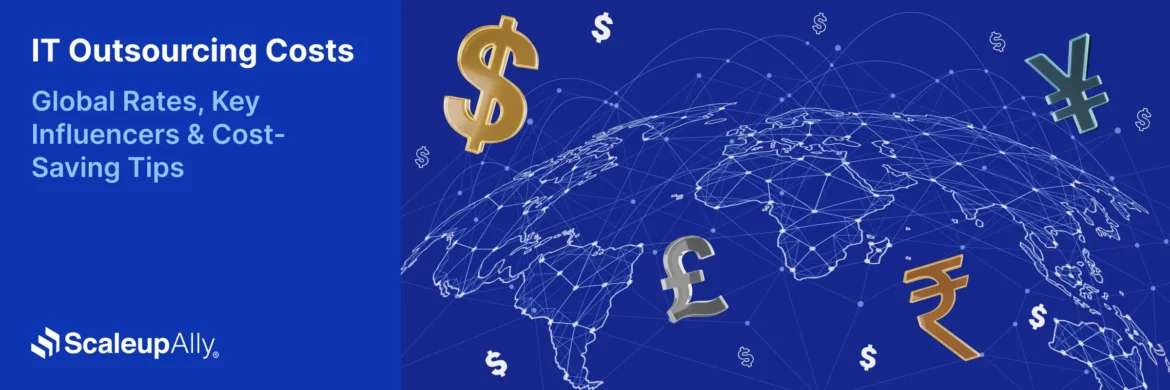
Healthcare IT Outsourcing: Benefits, Risks & Best Practices
Pranay Agrawal | April 3, 2025 , 13 min read
Table Of Content
In the UK, IT outsourcing led to a 20% reduction in overall IT expenses primarily due to reduced staffing costs and improved system uptime through the use of more advanced technology. However, the study also cautioned that data security risks increased when IT services were outsourced.
Healthcare IT outsourcing isn’t theoretical. It’s happening right now, with real consequences unfolding in hospitals and clinics globally. As medical costs soar and technical demands multiply, healthcare administrators face choices about where to direct their limited resources.
What separates success from failure in this space isn’t whether you outsource, but how you do it.
Behind these statistics are medical professionals making daily compromises. For example, the nurse waiting for remote tech support while patients pile up, the administrator calculating if IT savings justify potential risks, the CIO explaining to board members why patient records suddenly need to travel across international borders, etc.
With regulatory requirements growing more complex and cybercriminals increasingly targeting medical data, the decision to keep IT in-house or send it elsewhere has never carried more weight because this isn’t just about technology but about patients, their privacy, and ultimately, their lives.
In this blog, we will discuss the benefits, risks, and best practices for healthcare IT outsourcing. You’ll also learn how to choose the right partner and ensure compliance with healthcare regulations.
Key Takeaways
- Healthcare IT outsourcing can deliver substantial cost savings (15-20%) while providing access to specialized expertise that most facilities couldn’t afford in-house.
- The highest-value services to outsource include cybersecurity operations, cloud infrastructure, help desk support, and data analytics. These are areas where specialized knowledge delivers clear advantages.
- Major risks include data privacy vulnerabilities, loss of operational control, and hidden costs (the average healthcare breach costs $10.93 million per incident).
- Successful outsourcing requires healthcare-specific experience from partners, detailed SLAs tied to patient outcomes, and maintaining internal strategic capability rather than outsourcing all IT decisions.
- The right partner selection process should prioritize healthcare credentials, security protocols, cultural compatibility, and detailed transition methodologies to minimize disruption to patient care.
What is Healthcare IT Outsourcing?
- What is Healthcare IT Outsourcing?
- Benefits of Healthcare IT Outsourcing
- Key Healthcare IT Services to Outsource
- Frequently Asked Questions
- Cost of Healthcare IT Outsourcing
- Risks and Challenges of Healthcare IT Outsourcing
- Best Practices for Successful IT Outsourcing
- How to Choose the Right Healthcare IT Outsourcing Partner
- Conclusion
Healthcare IT outsourcing refers to transferring tech responsibilities from medical organizations to specialized external partners. These partnerships involve handing over entire operational functions (from electronic health record management to telehealth infrastructure).
When Mayo Clinic outsourced their cloud operations to Google in 2020, they were restructuring who handles sensitive patient data.
These arrangements typically cover:
- Clinical information systems
- Cybersecurity operations
- Network infrastructure
- Technical support
- Custom software development
- Data analytics
What distinguishes healthcare IT outsourcing from other sectors is the regulatory environment. Partners must be compliant with HIPAA, FDA requirements for medical devices, and international data protection laws.
The relationship can range from tactical (handling help desk calls) to strategic (designing enterprise-wide digital transformation), with contract structures varying from fixed-price models to outcome-based arrangements where vendors share both risk and reward.
Benefits of Healthcare IT Outsourcing
The decision to hand off your technical operations shouldn’t be made lightly. When executed thoughtfully, healthcare IT outsourcing can deliver unmatched advantages. Here’s what healthcare institutions can look to gain when they make the leap:
1. Cost Efficient
Hospitals outsourcing their IT typically reduce operational expenses by 15-20%. This is money that can be redirected to patient care.
2. Focus Returns to Medicine
A frustrated medical practitioner on Reddit put it bluntly: “I didn’t go to medical school to troubleshoot servers.” When healthcare professionals escape technical distractions, patient satisfaction scores climb. Organizations that outsource IT report higher physician satisfaction rates, largely because clinicians can refocus on medicine rather than wrestling with technical issues.
3. Scaling
Healthcare IT outsourcing creates elasticity impossible to achieve internally. When COVID-19 forced telehealth adoption overnight, facilities with outsourced IT infrastructure scaled virtual visits 200x faster than those managing technology in-house. External partners can rapidly deploy resources without the typical hiring delays and training cycles that plague internal expansions.
4. Expertise You Couldn’t Afford Otherwise
Small and mid-sized health centers gain access to specialized talent typically reserved for industry giants. A rural hospital can’t realistically employ a full-time blockchain security specialist or AI systems architect. However, through outsourcing, they can leverage that expertise precisely when needed.
5. Accelerated Innovation Cycles
Organizations outsourcing healthcare IT implement new technologies 8-12 months faster than those developing internally. External partners bring cross-industry experience and pre-built solutions that would take years to develop from scratch, allowing healthcare providers to leapfrog technological generations in critical areas like patient engagement and care coordination.
Key Healthcare IT Services to Outsource
Determining which technical functions to keep in-house versus delegate externally represents one of healthcare leadership’s most consequential decisions. While not every IT function belongs in outside hands, several areas have proven particularly suitable for outsourcing healthcare IT services based on risk-reward calculations and industry outcomes:
1. Cybersecurity Operations
With healthcare breaches costing an average of $10.93 million per incident, specialized security firms offer protection levels most hospitals can’t match internally. Organizations like Cleveland Clinic and Partners HealthCare outsource security monitoring, vulnerability management, and incident response, gaining 24/7 coverage and expertise in healthcare-specific threats that internal teams struggle to match.
2. Cloud Infrastructure Management
Managing on-premises data centers diverts critical resources from patient care. When Massachusetts General Hospital moved to a managed cloud model, they eliminated $3.7 million in hardware costs while reducing system outages by 74%. Cloud specialists bring economies of scale and expertise impossible to replicate in-house, particularly for smaller practices.
3. Help Desk & Technical Support
Patient care can’t stop because of technical issues. Outsourced help desks provide around-the-clock support for clinical staff without the scheduling complexity and overhead of internal support teams. MultiCare Health System’s outsourced technical support model decreased average resolution time from 27 hours to under 4 hours, directly improving clinical workflow efficiency.
4. Application Development & Maintenance
Custom healthcare applications require specialized development skills that fluctuate in demand. External development teams bring cross-industry experience and avoid the “knowledge island” problem that plagues internal teams when key developers leave. Boston Children’s Hospital’s outsourced application, delivered their patient portal 6 months ahead of their original internal timeline.
5. Data Analytics & Reporting
Transforming raw healthcare data into actionable insights requires specialized expertise in both technical analytics and healthcare contexts. Outsourcing healthcare IT services related to analytics provides access to data scientists with healthcare experience without carrying these high-demand professionals on payroll year-round.
6. Telehealth Infrastructure
The complexity of secure, HIPAA-compliant video consultation platforms exceeds most IT departments’ capabilities. Third-party telehealth specialists manage the technical complexities while healthcare providers focus on the clinical aspects of remote care delivery, significantly reducing failed connections and technical difficulties during patient consultations.
Frequently Asked Questions
Q: What is healthcare IT outsourcing?
Healthcare IT outsourcing refers to the process of transferring technological responsibilities from medical organizations to specialized external partners. This includes managing clinical information systems, cybersecurity, network infrastructure, technical support, and data analytics under contractual arrangements that must comply with healthcare-specific regulations like HIPAA.
Q: What are the top healthcare IT services to outsource?
The most beneficial healthcare IT services to outsource include cybersecurity operations (reducing breach risks), cloud infrastructure management (eliminating hardware costs), 24/7 technical support (improving clinical workflow), application development, specialized data analytics, and telehealth infrastructure. These areas typically deliver the highest ROI while requiring specialized expertise.
Q: How do I choose the best healthcare IT outsourcing partner?
Focus on healthcare-specific credentials (HITRUST, HIPAA expertise), security protocols (request SOC 2 reports), cultural compatibility with your organization’s values, financial stability, and comprehensive transition methodologies. Prioritize partners with documented experience in your specific EHR platform and similar-sized healthcare environments.
Cost of Healthcare IT Outsourcing
Healthcare IT outsourcing costs vary based on scope and the size of the healthcare organization. Small practices typically invest $25,000-75,000 annually for basic support services, while comprehensive enterprise solutions for hospital systems can range from $2-10 million.
Most providers report ROI within 14-18 months. The true calculation extends beyond direct expenses, factoring in reduced downtime (valued at approximately $8,662 per minute for healthcare organizations), eliminated recruitment costs, and avoided capital expenditures for hardware refresh cycles.
Contract structures typically include fixed monthly fees with variable components tied to service volumes or performance metrics.
Risks and Challenges of Healthcare IT Outsourcing

While the benefits can be substantial, IT outsourcing in healthcare brings challenges that must be carefully managed. Organizations that rush outsourcing decisions often discover these pitfalls too late, when the patient data is compromised:
1. Data Privacy and Security Vulnerabilities
Third-party access creates new attack vectors for patient data. The 2023 Change Healthcare breach exposed 100 million patient records through an outsourced billing system, resulting in $4.8M in fines. Organizations implementing IT outsourcing in healthcare must establish rigorous vetting protocols and continuous monitoring systems to prevent becoming the next cautionary tale in healthcare privacy failures.
2. Loss of Operational Control
When critical systems live outside your walls, responsiveness suffers. Dependency on external timetables and priorities can leave healthcare providers feeling powerless precisely when agility matters most.
3. Hidden Costs and Contract Complications
What looks financially appealing initially often grows more expensive over time. Some healthcare organizations encounter unexpected costs within a few years of outsourcing arrangements, primarily from “scope creep” and unforeseen integration requirements. Contracts that seemed straightforward during negotiations become minefields of interpretation as relationships evolve.
4. Regulatory Compliance Risks
Outsourcing doesn’t transfer compliance liability. Healthcare providers remain legally responsible even when third parties handle their data, creating a challenging oversight requirement many organizations struggle to fulfill effectively.
Best Practices for Successful IT Outsourcing
Organizations that thrive in successfully outsourcing healthcare IT operations follow specific best practices that maximize benefits while minimizing disruption of patient data and care:
1. Develop Clear Requirements and SLAs
Success begins with precision. Top-performing healthcare organizations develop detailed requirements documents that specify not just technical needs but clinical impacts and workflows. Effective SLAs in healthcare must account for the critical nature of medical systems where downtime isn’t just inconvenient but potentially life-threatening.
2. Prioritize Healthcare-Specific Experience
Generic IT expertise falls short in healthcare environments. Partners need to demonstrate an understanding of HIPAA compliance, clinical workflows, and healthcare-specific applications. When selecting vendors for IT outsourcing for the healthcare industry, prioritize those with verifiable experience in similar-sized medical organizations.
3. Establish Robust Governance Models
Successful outsourcing requires ongoing oversight, not just initial contracting. Establish multi-level governance structures with clearly defined escalation paths and regular executive touchpoints for weekly operational reviews, monthly management check-ins, and quarterly executive steering committee meetings to ensure alignment between clinical needs and IT delivery.
4. Maintain Internal Strategic Capability
Organizations flourishing with external IT partners maintain internal leadership positions focused on alignment between technology and clinical objectives. Cleveland Clinic preserves a core team of healthcare IT strategists who understand both the organization’s medical mission and technology landscape, allowing them to direct outside resources effectively while maintaining institutional control over critical decisions.
5. Create Collaborative Knowledge Transfer Processes
Prevent dangerous knowledge silos through structured information sharing. Effective healthcare organizations implement detailed documentation requirements, shadow programs, and cross-training initiatives between internal staff and outsourced teams.
How to Choose the Right Healthcare IT Outsourcing Partner
Choosing an IT partner for your healthcare organization means entrusting someone with your patients’ data, clinical workflows, and a vital part of your reputation. The difference between the right and wrong choice can be measured in millions of dollars and countless patient experiences. Here’s how you can choose the right healthcare outsourcing partner:
1. Verify Healthcare-Specific Credentials
Look beyond general IT certifications to healthcare-specific qualifications. Partners with HITRUST certification, HIPAA compliance expertise, and demonstrable experience with systems like Epic, Cerner, or Meditech bring contextual understanding that generalist firms lack.
2. Evaluate Security Infrastructure and Protocols
Your patient data deserves military-grade protection. Scrutinize potential partners’ security frameworks, breach response protocols, and compliance history. Request SOC 2 Type II reports covering at least 12 months of operations.
3. Assess Cultural Compatibility
Technical capability matters, but so does organizational fit. Partners who understand healthcare’s mission-driven nature typically outperform purely profit-focused vendors. Conduct site visits, speak with actual delivery staff (not just sales teams), and request references from organizations with similar cultures. When Providence Health switched vendors despite lower competing bids, they cited “alignment with our patient-first values” as the deciding factor.
4. Consider Geographic and Time Zone Coverage
Patient care happens 24/7 (your IT support should match). Evaluate partners’ ability to provide coverage aligned with your operational hours. Organizations with multiple global delivery centers often provide more comprehensive coverage than single-location providers, ensuring continuous expertise regardless of when issues arise.
5. Request Detailed Transition Methodology
The handoff process reveals much about a vendor’s operational maturity. Request specific transition plans including timelines, knowledge transfer approaches, and risk mitigation. Partners with documented methodologies and transition specialists demonstrate an understanding of healthcare’s low tolerance for disruption.
Conclusion
As patient care becomes increasingly digital, the technology decisions you make today will define your clinical capabilities tomorrow. Choose partners thoughtfully, govern them effectively and always remember—healthcare IT exists to serve people, not just systems.
If you’re still weighing the idea of outsourcing healthcare IT, don’t get stuck on whether to outsource. Instead, focus on how to do it in a way that advances what truly matters: delivering better care to the patients who rely on you.
Related Blogs

IT Outsourcing Costs Explained: Global Rates, Key Influencers & Cost-Saving Tips
Discover what IT outsourcing costs include, key pricing factors, hidden fees, regional rates, and how to pick a cost-effective outsourcing partner.
Pranay Agrawal
Nov 29 ,
13 min read

IT Consulting Rates Per Hour in 2025: Country & Industry Wise
Discover IT consulting rates broken down by experience, specialization, industry, and country. Plan your budget and find the right IT talent for your business needs.
Pranay Agrawal
Nov 25 ,
13 min read

Calculating ROI for Software Development: A Detailed Guide
Discover proven strategies and practical tips to enhance the ROI for software development projects. Learn how to measure success and increase profitability.
Manu Jain
Nov 25 ,
19 min read



